The species that is consistently on the top of target lists when fishing over inshore reef in tropical, and sub tropical, waters is the bar cheek coral trout. These magnificent looking, hard fighting, and great tasting fish are a prize catch in anyone’s books.
They are also known as an island trout or coastal trout and can be found in as little as 5m of water right down to 35m+. They are easily distinguishable by their bright blue bars that are tattooed across their face and body. Colouration can range from dark brown to a deep red depending on what depth of water they come from. Dark brown fish are mostly from shallow waters between 5-15m while redder fish tend to come from deeper water.
Regardless of colour, the best thing about them is they are not that hard to catch as long as you get the fundamentals right.
The first thing to consider when chasing bar cheek coral trout is where to fish. As the name coastal and island trout suggests these blue-barred beauties are usually found around coastal reef laden headlands, inshore reefs and islands; making them excellent targets for small to medium boat anglers.
On inshore reefs they tend to congregate on isolated bommies surrounded by sand, especially during September, October and November when they ready themselves to spawn. Not all bommies will hold coral trout, so the best way to spot a likely area is look for those that have dense populations of baitfish. Bar cheek trout love to hang around where they can get an easy feed at anytime as they can be quite gluttonous.
Bar cheek coral trout also congregate around islands that are on coral ledge drop-offs from hard reef to sand. Once again, target areas that have dense populations of bait. Finding these bait points can be as easy as spotting fusiliers congregating around coral areas as this is usually a sign that a healthy bait-filled bommie is below.
These coral trout consider themselves the ‘boss of the bommie’ and if you have ever seen one underwater you will understand this statement well. They will come from a distance if a disturbance takes place to inspect what’s going on and are known for their arrogance of staring down snorkelers with an almost ‘What are looking at, punk?’ glare. It is this ‘bullet proof’ style of behaviour that makes them easy targets for spearfishers; likewise line anglers also benefit from this behaviour.
Creating action and activity below the water is a great way to bring trout to your bait. Whether it is through catching fish or even banging a plastic, blade or octo jig on the sea floor, this will appeal to the inquisitive and curious nature of the bar cheek coral trout and, like all things, curiosity often kills the cat.
The final piece of the puzzle and probably the most important to consider when choosing a location, is to position baits, lures, plastics or jigs so they are fished into the pressure sides of bommies. Bar cheek coral trout, like most predators, love to face into the current and by fishing your presentation into areas where the current is pushing onto a bommie or ledge is vitally important. Fish behind this and you are wasting your time.
Current and tide can play a big part in fishing for bar cheek trout. Times of low light, dusk and dawn, are always great times to target them as they are not nocturnal feeders and are very rarely caught at night. There are plenty of anglers out there who have fished all night for nocturnal feeders, like large-mouth nannygai or fingermark, and then the moment the sun pops up over the horizon a steady string of bar cheek trout suddenly materialises out of nowhere.
Bar cheek trout, like most reef dwellers, tend to hole up in bommies at night to escape the reef sharks, which really become active on the reef once the sun sets.
If you can coincide these times of low light with a tide change and when the water begins to move then your chance of bar cheek trout success will improve. Don’t be put off by big tidal movements as these big runs can often fire up the bite, especially in shallow inshore areas around 15m deep. Once again, just make sure you are fishing into the front of current affected spots.
Bait selection is also important and while the humble pilchard has been slaying bar cheek trout for decades, fresh is always best.
A bait that is dynamite for inshore trout is the greenback herring. Not only does it have its own berley and smell, due to its oily flesh, it also brings a degree of attraction with its silvery flanks. Mostly considered as estuarine bait, the humble herring is much sought after by those chasing bar cheek trout. Those in the know will often sacrifice fishing time, by cast netting for the greenback critters in harbours and boat ramps before heading out onto the reef.
If you don’t soak baits then you are in luck because the bar cheek coral trout fancies anything that moves, wiggles and makes plenty of noise and attention. Plastics such as 7” jerk shads, big grubs and paddle-tails and vibes create plenty of vibration and noise that trout find hard to resist.
Spice up your presentation by using PE Tackle flies and adding that extra bling to your bait or soft plastic. It will not only draw in the fish but also draw a solid bite.
When using artificials for trout you only have to work the bottom third of the water column as they tend to be bottom dwellers. Use your sounder to evaluate when you have reached this mark to save time and energy. Don’t be too hesitant to move spots either as bar cheeks will often stare down a bait for a while before deciding to strike. Keep working it in the bottom third during a single cast for a good five minutes before casting to another spot.
The final basic to get right is the fight. Bar cheek trout are not long haul fighters however they are renowned for putting all their effort into the initial strike where they will try like mad to get back to the reef once swallowing the bait. This is where a tight drag of at least 6-8kg is necessary as the angler must turn their head on the initial strike to get success. This is the reason why many northern fishers prefer to fish for bar cheek trout with handlines, as you can muscle them out of the fight pretty quickly.
Once you have turned their head, the fight is pretty non eventful. It can often be described at pulling a bucket of water to the surface. In fact once you have caught a few it can be easy to pick a trout from other reef fish before it gets to the boat due to their lack of fight.
For bait fishing, rigs are quite simple and a running ball sinker straight to the hook is a favoured by many, especially in shallow water. Dropper rigs can also be used particularly if the ground below is extremely snaggy. Whichever rig you favour ensure your leader is strong and abrasive as it will be rubbing against all manner of reef and if you hook a solid trout you can bet that you may have to muscle the fish out of hole or two. Trout have big mouths so big hooks up to 8/0 and big baits are essential. Remember these fish have a similar attitude to food as cod and are more likely to swallow something large than small.
Bar cheek trout are a great tropical species to target and it seems they are becoming more and more prevalent in southern waters as well. So if you are keen on snaring one of these blue barred beauties put a little time and effort into getting the basics right and success will come your way.
Differences between bar cheek trout, common coral trout and blue spot trout:
Bar cheek trout
Found mostly around inshore areas and is distinguishable by its long blue bars across its face and body instead of spots like the other species of coral trout. Minimum size length is 38cm with no maximum size length.
Common or leopard trout
The common trout is distinguishable by small blue dots across its face and body and a large blue ring around its eye. It also has a transparent pectoral fin. Minimum size is 38cm with no maximum size length.
Blue spot trout
Found on offshore reefs it is distinguishable from common trout by their non transparent pectoral fin. While having the same spots as the common trout they are generally larger on a blue spot trout. Minimum size is 55cm with a maximum size of 80cm, due to ciguatera risk.
Trout-
The author with an average-sized bar cheek coral trout. The distinctive dark blue bars across its face is the easiest way to identify this coral trout from other species.
Reads: 19950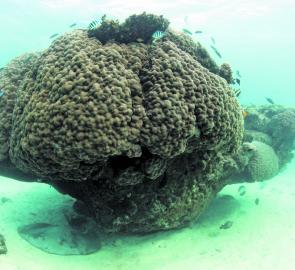
This is an excellent example of a bommie worth fishing for trout – isolated and surrounded by sand with plenty of bait around.
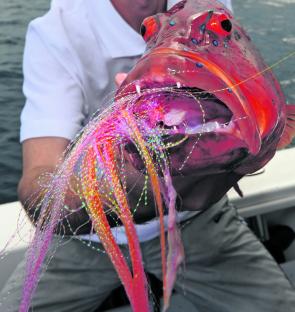
Pimping up your baits, like using PE Tackle flies, are an excellent way to snare a big bar cheek coral trout.
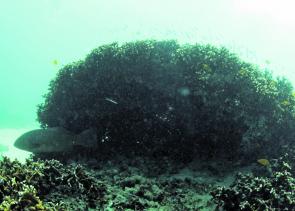
A bar cheek coral trout lies in wait on a bait-filled bommie in less than 3m of water.
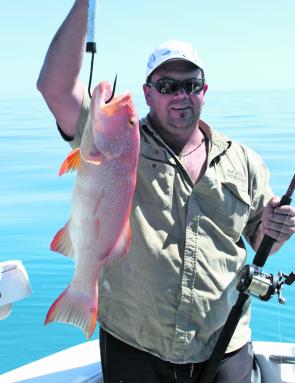
The light pink colouration of this bar cheek trout is a sign that it was taken from deeper water.
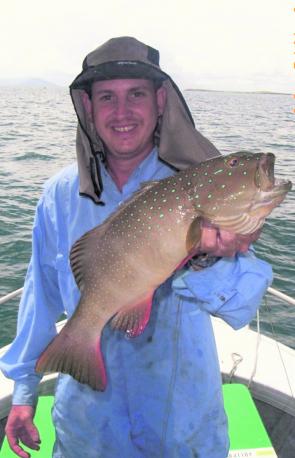
Dark brown fish are mostly taken from shallow waters between 5-15m. The redder fish tend to come from deeper water.
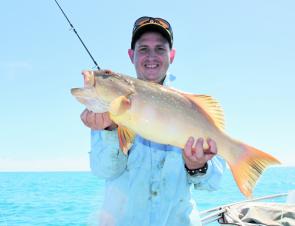
The author’s PB trout taken on soft plastic. Even though the fish was snared on a soft plastic, the author attributes the capture to the commotion caused by previously jigging an octo jig.

Two very healthy bar cheek trout snared from the fringing reefs of an island. These fish tend to congregate in good numbers in the spring months so double hook ups are not uncommon.
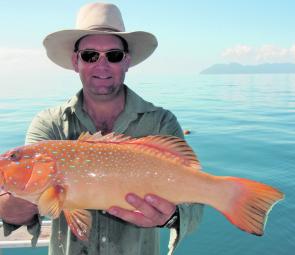
Bar cheek trout can be taken from a huge range of depths; less than 3m right up to 36m, which is where this one was caught.




